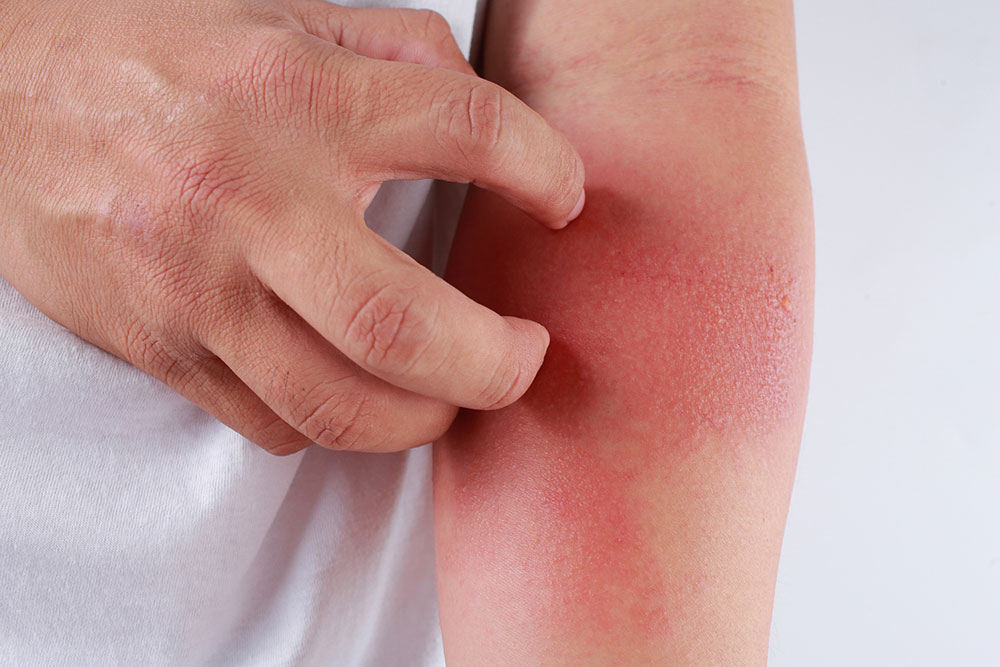All You Need to Know about Eczema

All You Need to Know about Eczema
Eczema is a skin condition that is characterized by patches of skin that become inflamed, rough, itchy, cracked, and red. Sometimes, even leading to blisters. Different stages and types of eczema affect almost 31.6% of people in the country. The word “eczema” is also used to specifically talk about “atopic dermatitis”, which is the most common type of eczema.
Types
Eczema has many types. These types can be identified with the help of eczema photos and also the symptoms. Some of the common types of eczema are:
Atopic dermatitis
- Atopic dermatitis is a health condition that has a genetic base. It is one of the most common types of eczema.
- Atopic dermatitis does not have an allergic base. This disease has a tendency of beginning early in the life of those who have a predisposition to inhalant allergies.
- The characteristics of this condition are rashes on the cheeks, neck, elbow and knee creases, and ankles.
Allergic contact dermatitis
- In the case of contact dermatitis, there are two types. One of these is irritant based which occurs because of a direct reaction to an allergen.
- The second type is allergic, and this occurs because of a delayed reaction to an allergen.
Seborrheic dermatitis
- This is another type of dermatitis where you can see rashes on the face, scalp, ears, and in the case of adults, the mid-chest area as well and which easily identified as you look at eczema photos clicked during the screening.
- This is different for infants. It produces a weepy, oozy rash behind the ears and can be quite extensive at the time, wherein it involves the entire body.
Dyshidrotic dermatitis
- Dyshidrotic dermatitis causes itchy, scaly patches of skin that become red, cracked, painful, and also flaked. It affects the fingers, soles of the feet, and also palms of the hand.
Nummular dermatitis
- Nummular dermatitis usually affects the legs and is common in men. In winter, it causes dry and round patches of skin.
Symptoms
Eczema is a disease that can occur frequently. It is very important to identify the symptoms of the disease before the condition worsens.
The following are some of the common signs and symptoms of eczema:
Symptoms in infants (under 2 years of age) :
- Bubbling up of rashes before leaking fluid.
- The appearance of rashes most commonly on the scalp and the cheeks.
Symptoms in children aged 2 years and above (till puberty) :
- In this case, rashes mostly appear behind the creases of the elbows and the knees.
- These are also seen on the neck, wrists, ankles, and the crease between the buttocks and legs.
After a period of time, certain other symptoms are also visible, including:
- The rashes become bumpy and turn into dark or light color.
- The process named lichenification can also occur. This results in thickening of the skin and the rashes develop knots and a permanent itch.
Symptoms in adults:
- Rashes cover much of the body.
- Rashes can be prominent on the face, neck, elbows, knees, and around the eyes.
- Rashes can also cause very dry skin, lead to skin infections, and can be permanently itchy.
With the eczema photos, proper identification of the causes and symptoms is possible. Also, the eczema photos will help a person to analyze the severity of the disease.
Causes
We have already seen the various symptoms of eczema. There are various factors due to which eczema occurs. The following are the causes:
- It is believed by many people that eczema is triggered by an immune system that is overactive and responds aggressively to the presence of irritants.
- At times, this disease is also caused by an abnormal response to the proteins that are a part of the body.
- Loss of the ability to distinguish between body proteins and invader proteins is another cause which results in inflammation.
- When one or more symptoms appear together, it is called an eczema flare-up. The prominent triggers of eczema flare-ups are synthetic fabrics, raised body temperature, sweating, temperature changes, stress, a sudden drop in humidity, upper respiratory infections, and rough scratchy material (such as wool).
Treatment and cure
In the case of eczema, there is no cure as of now. All that can be done is to treat the patients for easing the symptoms.
The treatment for eczema mainly depends on the age and severity of the disease. The following methods are used for treatment:
- Over-the-counter (OTC) remedies
- Prescription topical medications
- Phototherapy
- Immunosuppressants
- Biological drugs
Some of the people also find success when they go for natural and alternative treatments.
In the case of most eczema conditions, managing the flare-ups come down to these essentials:
- You should know your triggers so that you can avoid exposure
- You should implement a daily bathing and moisturizing routine
- You should use OTC and prescription medication consistently
Bottom line
Eczema is very common in many parts of the world, especially in the United States of America. It is essential to have a proper understanding of the disease in order to get it treated.



